In this modern era of different technologies, the contribution of electric bicycles has been phenomenal. It has made the daily commutes so easy and eco-friendly, giving both nature and humans the things which are good for them.
But the most intriguing thing would be to know how an electric bicycle works and the electric bicycle parts name which are involved in making it. Learning about their functions will also help you know how these ebikes work in general.
In this blog, we will be decoding electric cycle parts name and their functions, so that you understand the concepts related to electric bikes practically in future.
Let’s just get straight inside this without further ado.
What’s an Electric Bicycle & How It Works?
There are technicalities in the electric bike’s functioning because it is an electric machine. But in a very easy and simple language, it starts from pedalling your cycle with the energy going to the motor and your bike moving forward.
This is very similar to the traditional bike but let us see how an electric bike actually works.
The battery and the motor are the soul components of an electric cycle because that’s how the mechanical energy is turned into electrical energy. And that’s how an electric cycle or bike moves forward.
When the rider starts pedaling the bike the sensors detect the movement and then activate the motor. This provides an additional boost to the power to augment the rider’s pedalling effort.
To control the flow of the energy from the battery there is a controller. This regulates the power output of the cycle based on the rider’s input. This is the way a bike works.
But we talked about just 3 components here, There are many components when it comes to the parts of the electric bicycle. Let’s start with listing and knowing more about them.
If you are interessted in buying an electric cycle, read our comprehensive article on electric cycle buyinng guide.
Electric Bicycle Parts List & Functions Explained
1. Battery
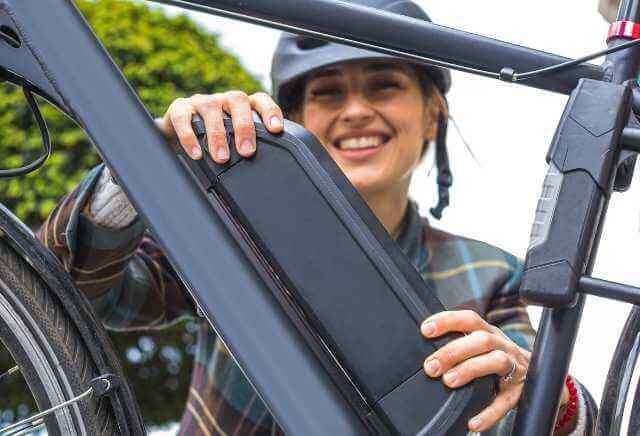
It is one of the most important parts of an electric bike or cycle. The battery is the powerhouse of the bike as it supplies the necessary electrical energy to the bike for proper functioning.
Its primary function is to store and deliver power to the electric motor when required. That’s why it is considered a fuel source and should be taken care of properly.
Generally, electric bicycles have lithium-ion batteries as such batteries are powerful, very lightweight and last longer. These batteries are recharged using a charger through electricity. Never overcharge otherwise its lifespan will reduce.
I. Battery charger
The battery charger as the name suggests is used to charge the battery when it runs out of charge. It converts the AC from any outlet to the appropriate DC that could charge the battery.
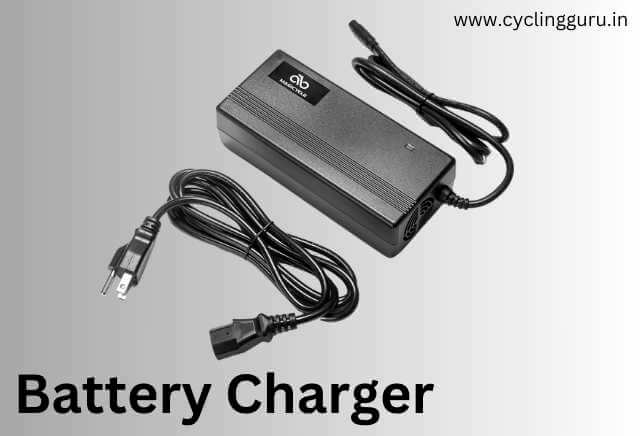
It is advisable to use the charger that comes with the bike and not any other company. Also, make sure there are no wear and tears in the battery charger because this would lead to current loss and your battery does not get any charge.
Also, charge the battery only when it has a little bit of charge left, i.e., put it to charge at around 20% but never let it go out of charge.
2. Motor (Hub motor vs Mid-drive motor)
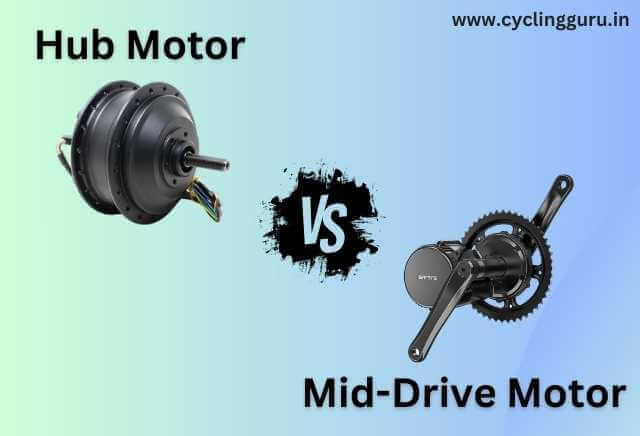
After the battery one of the most crucial components in an electric bicycle is the MOTOR. It assists the rider in pedalling, making it easier for the person to ride the bike.
Let’s learn about two common types of motors used in electric cycles:
I. Hub motor
A hub motor is situated in the hub (near the rear or the front wheel), that’s why they are called a hub motor. Its primary function is to directly drive the wheel when the bike is getting pedalled forward or powered through the throttle.
Hub motors are known for their simplicity, easy usage, cheap price, etc. They provide a very smooth and quiet ride and require little to no maintenance.
Such types of motors are equipped in regular electric bicycles, entry-level electric MTBs, hybrid electric bicycles, etc.
Talking about the speed & torque of hub motors, you would get a maximum speed of up to 25 km/h with a normal amount of torque in India as the government restricts the maximum speed of such electric cycles.
II. Mid-drive motor
Whereas the mid-drive motor is attached to the bottom bracket of the bike, where the pedals and the crankset are located. The design of the placement allows the motor to transfer power through the bike’s drivetrain utilizing the gears.
This is the most significant advantage of the mid-drive motor in that it uses the gears to the full use as it has a higher amount of torque. And the speed will be the same on such motors as well.
Mid-drive motors are mostly used in mountain electric bikes, cargo electric cycles, dirt electric bicycles and some hybrid electric bicycles.
3. Controller
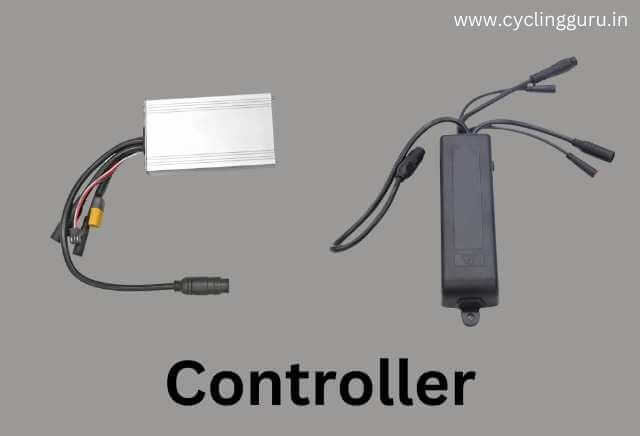
The controller serves as the brain of the whole system as it regulates electric power and controls the flow of the current (power) from the battery to the motor. It takes the input from the rider and gives the output accordingly.
The controller ensures smooth and efficient delivery of the power which enhances the riding experience for the rider. It can also impose the speed limits on the bike as well as control the user interface which enhances the overall functionality of the bicycle.
4. Throttle
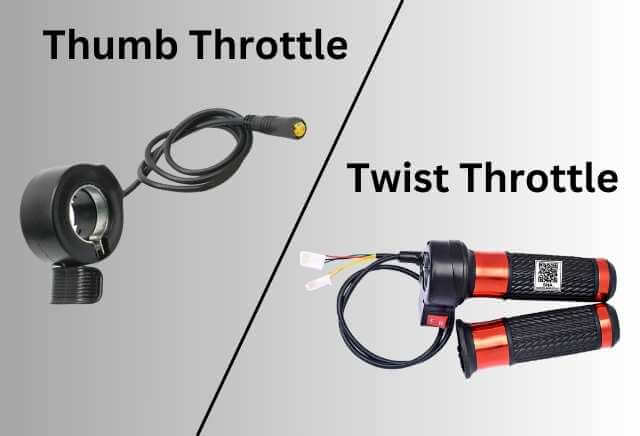
In simple words, the throttle is the control mechanism, found in electric bikes which allows the riders to activate the motor without pedalling. Its main function is to provide the rider with the ultimate power over the motor’s power output.
It is attached to the handlebar so that it is easily accessible to the riders. When it is pressed or twisted, it sends a signal to the controller, instructing the motor to start so that the bike moves forward.
The main idea is to give the rider the power to accelerate the bike without pedalling and it comes very handy when starting the bike from a standstill.
5. Pedal Assist Sensor (PAS)
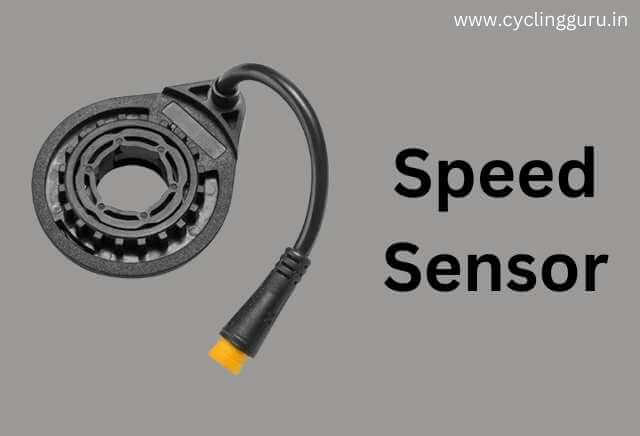
PAS is the pedal assist system on an ebike. It is designed to provide the bike with electrical assistance to the rider’s pedalling efforts. The PAS is built in such a way that when the rider starts pedalling, a sensor sends instructions to the controller and the controller activates the motor accordingly.
When the rider starts continuous pedalling the PAS activates the motor and delivers the appropriate level of assistance that is required. Additionally, there are some levels of pedal assist means higher levels need less pedalling effort and vice-versa.
6. The Torque Sensor
A torque sensor is equipped in an e-bicycle to enhance the overall performance of the bike. But How?
When the rider pedals, it performs its task, it measures the torque or the force that the rider is applying to the pedal and then it provides the real-time feedback to the controller. Then the controller adjusts the power of the motor accordingly.
7. E-brakes
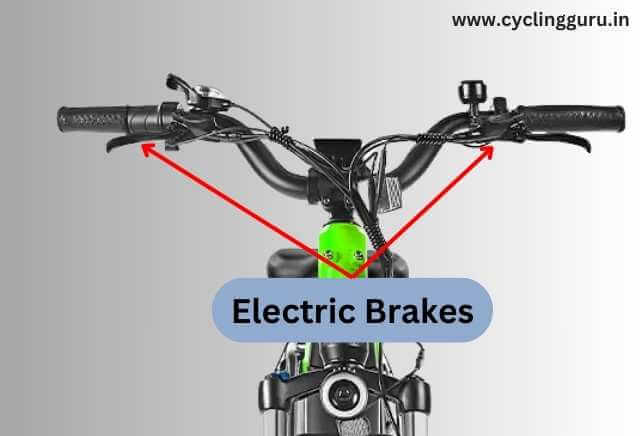
You already know that the brakes are already there in any bicycle whether it is electric or normal. But What’s “E” here?
“E” stands for electric. Yes! You read correctly. In electric bicycles, brakes are electrically assisted or controlled because of the motor. These brakes have functions similar to the traditional brakes but they are a bit more enhanced and advanced.
When the rider pulls the brake lever, it sends the message to the controller to cut the power supply to the motor so that the motor also stops while braking. That’s how the E-brakes work with the auto cut-off feature.
8. Display
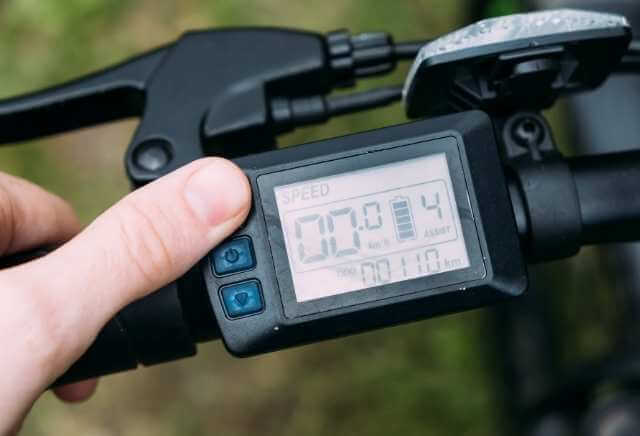
A display also known as the dashboard of the electric bicycle, is used to see useful information such as speed, battery charge level, distance, pedal assist level, etc.
As the name suggests, it displays the essential information on the screen in a very user-friendly manner. It also displays the setting which is accessible to the rider and they can adjust them as they go about in their journey.
It is a very essential and very practical component and very important in terms of safety.
9. Torque Arm
The torque arm prevents the motor axle from rotating or twisting. Generally, the electric motor generates a lot of torque when the rider rides the electric cycle. This is more significant in high-powered electric bicycles.
This torque arm acts as a protector of the motor and makes sure that it stays intact and does not fall out during these operations. The torque arm is installed in the non-drivetrain side of the bike and then is connected with the frame dropout.
10. Hall Sensor
A Hall effect sensor is a magnetic sensor, found on an electric bike motor’s rotor, that serves a crucial role. It detects magnetic fields and relays this data to the controller, enabling precise motor positioning.
Consequently, the motor adapts its power output accordingly for optimal performance. This allows the motor to maintain a consistent speed regardless of terrain or load. As a result, the electric bike can travel long distances with maximum efficiency.
Additionally, this sensor also helps to protect the motor from damage due to overloading. It also ensures that the motor is operating within the correct parameters.
These were the most important electric bicycle parts, Apart from these there are many mechanical parts such as frames, tires, rims, saddles, and so on. Learn more about bicycle parts names by reading our comprehensive article on bicycle anatomy.
Tips for Maintaining Your Electric Cycle
There are a few tips and tricks that you can follow to maintain your electric cycle.
1. Keep your battery in healthy condition
As I have already mentioned above an ebike’s battery is the soul of an ebike so you must inspect it on a regular basis and keep the contacts of the battery clean to prevent any corrosion.
- For storing the battery follow the instructions given in the manufacturer’s guidelines.
- Charge the battery with the original charger (provided by the brand).
- Avoid exposing the battery to extreme temperatures as much as you can and always ensure that it is properly fitted to the bike.
- When not in use, store it properly in a secure and dry area and away from direct sunlight. This will ensure that there are no chemical reactions happening inside the battery that would destroy it.
- Also, avoid overcharging and undercharging the batteries. This reduces the lifetime of the battery and also reduces the efficiency.
2. Lubricate the drivetrain for smooth functioning
Remove all the dirt and debris from the drivetrain (chains, cassettes, etc) for the smooth working of your ebike. You should apply lubricant to the chains to reduce friction and increase the performance of the bike.
3. Make sure to maintain optimum tire pressure
If your e-bicycle has less air pressure, it will consume more battery power and will provide you with less speed. Therefore, to ensure efficiency and smooth ride, always make sure your cycle has optimum tire pressure.
Also, Inspect for wear and tear and replace them if there are any because they also help in enhancing the battery range.
Conclusion on Electric Bicycle Parts Name
There are a lot of things when it comes to electric bicycle parts or electric bikes as a whole. So many components and so many functions are related to each other.
It is important for us to study them and analyze them to understand better how an electric cycle works. And what are the dos and don’ts for e-bicycles? The motive of this blog was to help you better understand the technicalities in one place.
I hope this article has helped you understand the electric bicycle parts names with their functions. If you have any questions or suggestions you can drop that down in the comments for me to get back!


